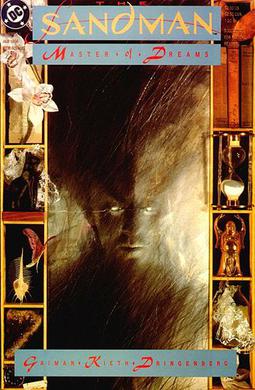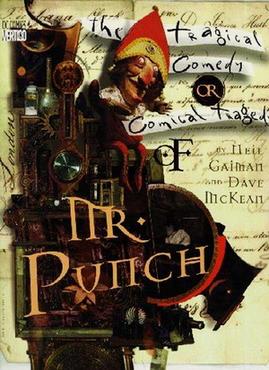
Neil Richard MacKinnon Gaiman is an English author of short fiction, novels, comic books, graphic novels, audio theatre, and screenplays. His works include the comic book series The Sandman and the novels Good Omens, Stardust, Anansi Boys, American Gods, Coraline, and The Graveyard Book. He co-created the TV series adaptions of Good Omens and The Sandman.

From Hell is a graphic novel by writer Alan Moore and artist Eddie Campbell, originally published in serial form from 1989 to 1998. The full collection was published in 1999 by Top Shelf Productions.

The Sandman is a comic book written by Neil Gaiman and published by DC Comics. Its artists include Sam Kieth, Mike Dringenberg, Jill Thompson, Shawn McManus, Marc Hempel, Bryan Talbot, and Michael Zulli, with lettering by Todd Klein and covers by Dave McKean. The original series ran for 75 issues from January 1989 to March 1996. Beginning with issue No. 47, it was placed under DC's Vertigo imprint, and following Vertigo's retirement in 2020, reprints have been published under DC's Black Label imprint.

Death: The High Cost of Living is a comic written by Neil Gaiman with art by Chris Bachalo and Mark Buckingham. It is a spin-off from Gaiman's best-selling Vertigo Comics series The Sandman, featuring the Sandman (Dream)'s elder sister, Death of the Endless. Its premise is that Death takes human form once a century, to remain grounded and in touch with humanity, an idea touched upon in several other media, for example in the 1934 film Death Takes a Holiday and in the Terry Pratchett novel Reaper Man.

David McKean is an English artist. His work incorporates drawing, painting, photography, collage, found objects, digital art, and sculpture. McKean has illustrated works by authors such as Neil Gaiman, Grant Morrison, Heston Blumenthal, Ray Bradbury and Stephen King. He has also directed three feature films.

Colleen Doran is an American writer-artist and cartoonist. She illustrated hundreds of comics, graphic novels, books and magazines, including the autobiographical graphic novel of Marvel Comics editor and writer Stan Lee entitled Amazing Fantastic Incredible Stan Lee, which became a New York Times bestseller. She adapted and did the art for the short story "Troll Bridge" by Neil Gaiman, which also became a New York Times bestseller. Her books have received Eisner, Harvey, Bram Stoker, Locus, and International Horror Guild Awards.

Understanding Comics: The Invisible Art is a 1993 non-fiction work of comics by American cartoonist Scott McCloud. It explores formal aspects of comics, the historical development of the medium, its fundamental vocabulary, and various ways in which these elements have been used. It expounds theoretical ideas about comics as an art form and medium of communication, and is itself written in comic book form.

MirrorMask is a 2005 dark fantasy film designed and directed by Dave McKean and written by Neil Gaiman from a story they developed together. The film stars Stephanie Leonidas, Jason Barry, Rob Brydon, and Gina McKee.

Drawn & Quarterly (D+Q) is a publishing company based in Montreal, Quebec, Canada, specializing in comics. It publishes primarily comic books, graphic novels and comic strip collections. The books it publishes are noted for their artistic content, as well as the quality of printing and design. The name of the company is a pun on "drawing", "quarterly", and the practice of hanging, drawing and quartering. Initially it specialized in underground and alternative comics, but has since expanded into classic reprints and translations of foreign works. Drawn & Quarterly was the company's flagship quarterly anthology during the 1990s.

Marc Hempel is an American cartoonist/comics artist best known for his work on The Sandman with Neil Gaiman.

Paul Gravett is a London-based journalist, curator, writer, and broadcaster who has worked in comics publishing since 1981.

Escape magazine was a British comic strip magazine founded and edited by Paul Gravett and Peter Stanbury. Nineteen issues were published between 1983 and 1989. Eddie Campbell, Phil Elliott and Glenn Dakin were amongst the many cartoonists published within its pages. Escape Publishing also released a limited number of graphic novels in the period 1984–1989, some co-published with Titan Books.

A1 is a graphic novel anthology series published by British company Atomeka Press. It was created in 1989 by Garry Leach and Dave Elliott. In 2004 it was restarted, publishing new and old material.

The Tragical Comedy or Comical Tragedy of Mr. Punch or simply Mr. Punch is a graphic novel written by Neil Gaiman, illustrated and designed by Dave McKean. It was published in 1994.

This is a list of works by Neil Gaiman.

The Graveyard Book is a young adult novel written by the English author Neil Gaiman, simultaneously published in Britain and America in 2008. The Graveyard Book traces the story of the boy Nobody "Bod" Owens who is adopted and reared by the supernatural occupants of a graveyard after his family is brutally murdered.

"Whatever Happened to the Caped Crusader?" is a 2009 story featuring the DC Comics superhero Batman. The story is published in two parts in the "final" issues of the series Batman (#686) and Detective Comics (#853), released in February and April, respectively. Written by Neil Gaiman, pencilled by Andy Kubert and inked by Scott Williams, the story is purported to be the "last" Batman story in the wake of severe psychological trauma that Batman endures within the story Batman R.I.P. and his ultimate fate in Final Crisis.

The Ocean at the End of the Lane is a 2013 novel by British author Neil Gaiman. The work was first published on 18 June 2013 through William Morrow and Company and follows an unnamed man who returns to his hometown for a funeral and remembers events that began forty years earlier. The illustrated edition of the work was published on 5 November 2019, featuring the artwork of Australian fine artist Elise Hurst.

Black Orchid is an American comic book written by Neil Gaiman with art by Dave McKean. It was published by DC Comics as a three-issue limited series from December 1988 to February 1989, and was later reprinted in trade paperback form. Black Orchid follows two girls, Flora and Suzy, who awaken in a greenhouse. Their journey to find out who they are leads them into contact with DC Universe figures like Batman and Swamp Thing, but also into conflict with criminal mastermind Lex Luthor, who seeks them for his own interests.
The Society of Strip Illustration (SSI), later known as the Comics Creators Guild, was a British network for all those involved in any stage of the creative process of comics production. The SSI, which was co-founded in 1977 by Denis Gifford, met monthly in London, published a newsletter, and distributed annual awards for achievement in the field. Despite the organization's name, most members were comic book creators, as opposed to those of comic strips like those found in The Beano and The Dandy.



















